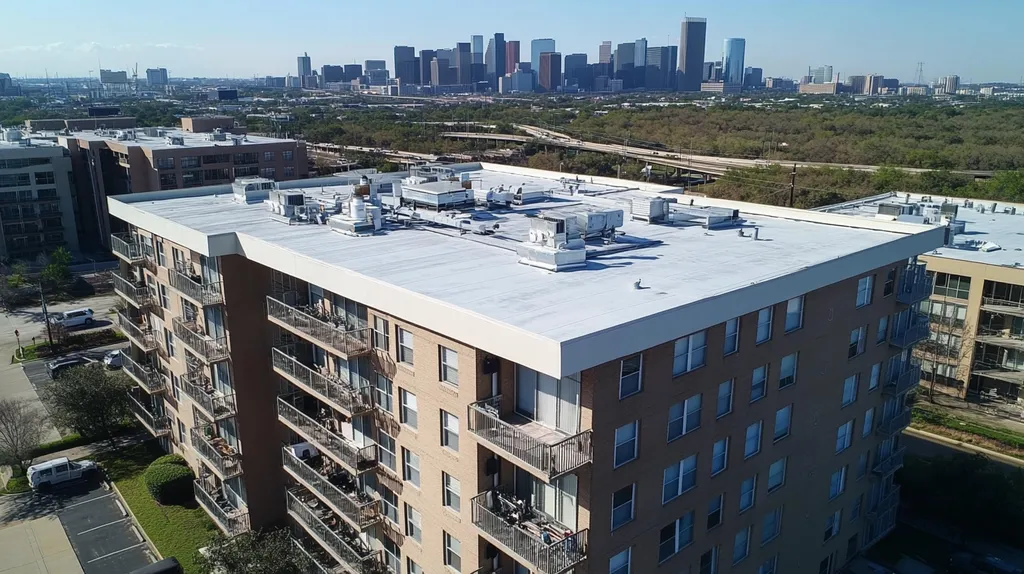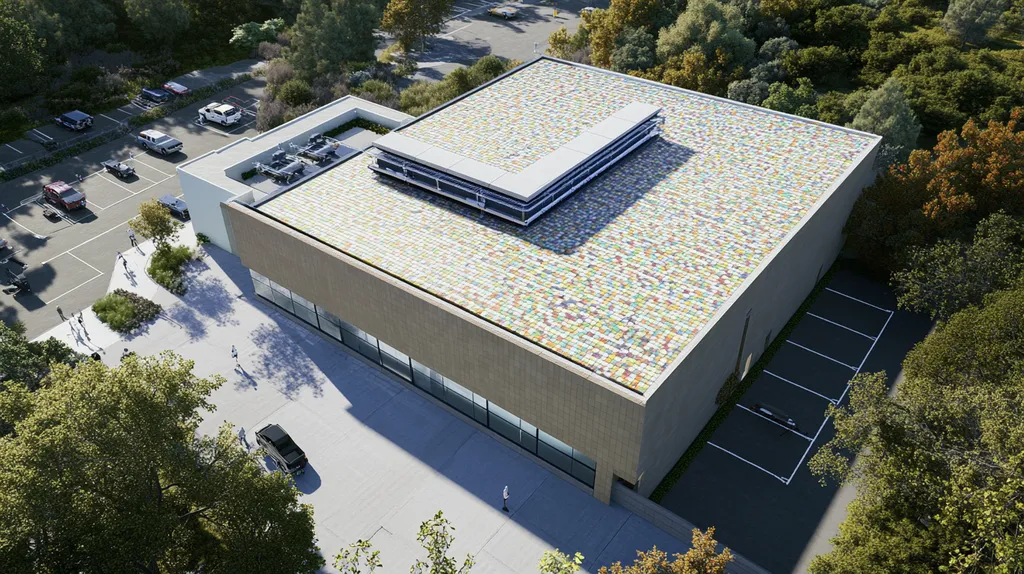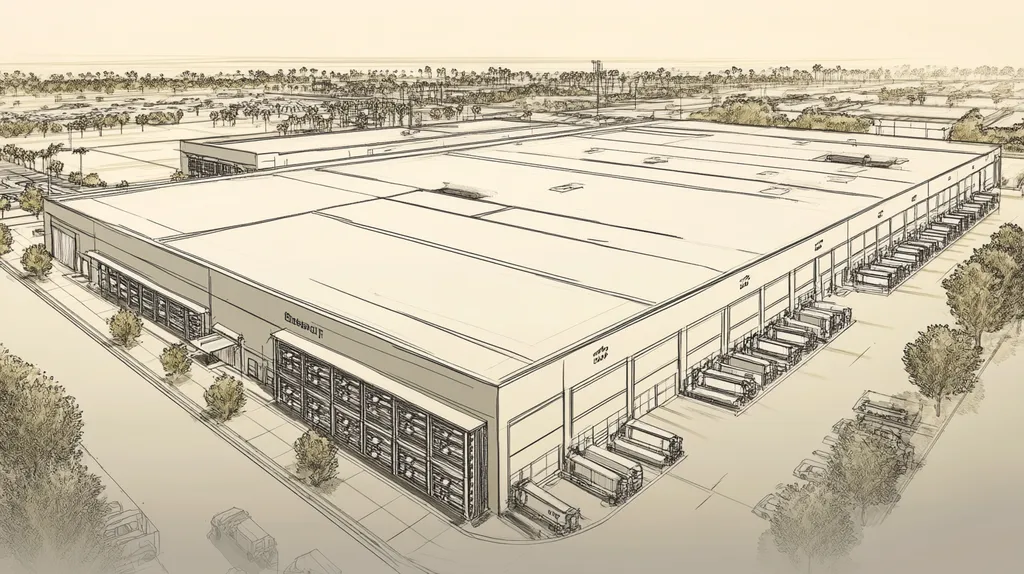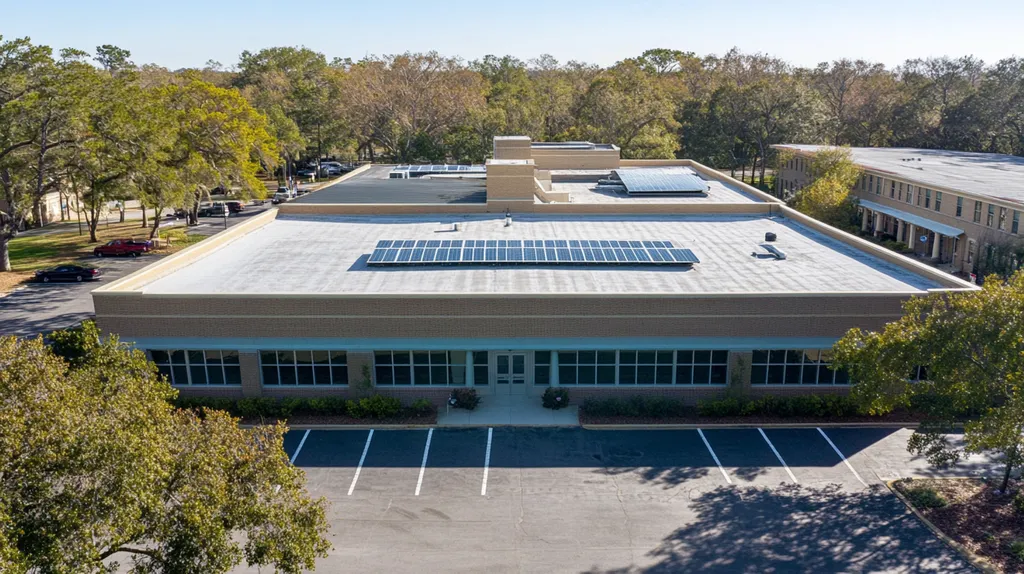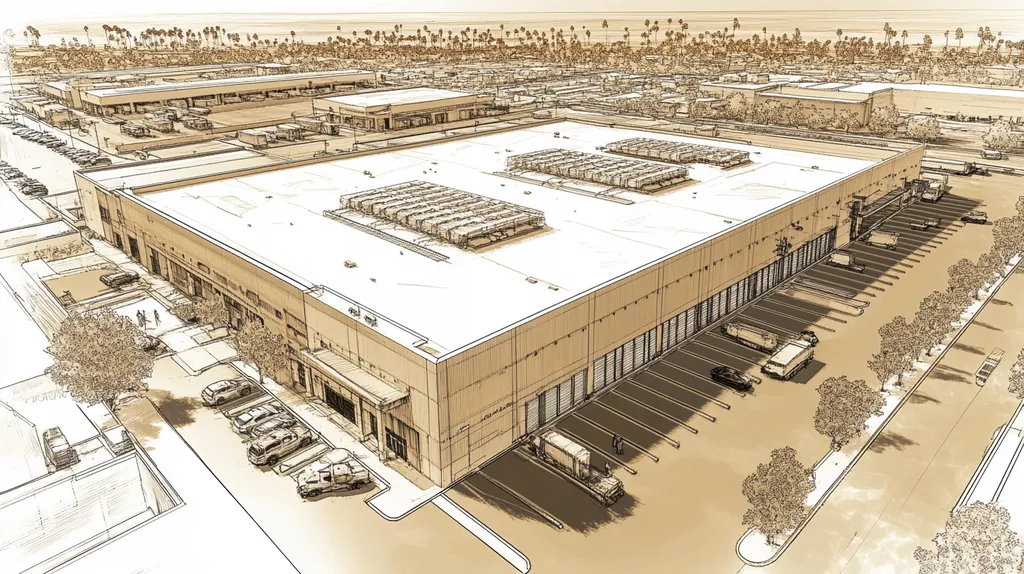Industrial roof projects can halt production lines, damage inventory, and cost facilities up to $45,000 per hour in operational losses. Even minor roofing disruptions threaten business continuity, product quality, and customer relationships.
This comprehensive handbook provides facility managers and property owners with proven strategies to maintain operations during crucial roofing work. From risk assessment and material selection to real-time monitoring systems, these methods help protect both facility assets and production schedules.
By following systematic approaches to planning, implementation, and optimization, organizations can execute essential roofing projects while keeping their core business functions intact.
SECTION 1: FUNDAMENTAL CONCEPTS
Industrial roofing projects present significant operational challenges that can severely impact business performance. Studies show that unplanned roofing disruptions cost industrial facilities an average of $45,000 per hour in lost productivity. Beyond immediate financial impacts, poorly managed roof projects can compromise product quality, worker safety, and customer relationships. Understanding and implementing fundamental business continuity concepts is crucial for protecting operations during these essential but disruptive projects.
Principles of Business Continuity in Roofing Projects
Business Continuity Management (BCM) in roofing projects requires a structured approach that distinguishes between routine challenges and potential crises. A comprehensive framework helps organizations develop and sustain effective policies, plans, and protocols for managing risks during roof work. (source: BLYTH)
The foundation of effective continuity planning starts with mapping critical business functions against roofing project phases. This includes identifying production areas that cannot tolerate disruption, determining acceptable downtimes, and establishing clear triggers for implementing contingency plans.
Successful continuity strategies must address three key elements: protection of sensitive equipment, maintenance of production schedules, and preservation of product quality standards. Each element requires specific protocols and responsible parties.
Communication frameworks between roofing crews and facility personnel need clear escalation paths and decision-making authority. This ensures rapid response to emerging issues before they impact operations.
Risk Assessment and Impact Analysis for Roof Work
Risk assessment for industrial roofing begins with a systematic evaluation of potential failure points where roofing activities intersect with business operations. This includes analyzing both direct impacts like water infiltration and indirect effects such as dust contamination.
Critical production areas require specialized protection strategies based on their vulnerability to roofing activities. These strategies might include temporary containment systems, staged work sequences, or specialized equipment protection protocols.
Weather patterns must be factored into risk calculations, as they can dramatically affect both roofing work and facility operations. Detailed contingency plans should address various weather scenarios and their operational implications.
Financial impact analysis must consider both immediate costs and long-term consequences of different risk scenarios. This includes quantifying potential losses from production delays, product damage, and customer relationship impacts.
Legal and Regulatory Considerations in Industrial Roofing
Industrial roofing projects must comply with multiple regulatory frameworks, including OSHA safety requirements, local building codes, and industry-specific regulations. Compliance failures can result in work stoppages and significant fines.
Environmental regulations play an increasingly important role, particularly regarding material disposal and air quality management during roof work. Facilities must maintain detailed documentation of compliance measures throughout the project.
Insurance requirements demand careful attention, as coverage gaps can expose facilities to substantial liability. This includes verifying appropriate coverage levels for both the roofing contractor and the facility.
Contract documentation must clearly define responsibilities and liabilities between all parties involved in the roofing project. This includes specific provisions for business interruption scenarios and damage to facility operations.
SECTION 2: SYSTEM COMPONENTS
Industrial roofing systems represent critical infrastructure that directly impacts operational stability. Studies show that 85% of premature roof failures stem from poor component selection or improper installation rather than normal wear. When essential system components fail, facilities face average downtimes of 3-5 days, resulting in substantial production losses and missed deliveries. Understanding and selecting the right components is fundamental to maintaining business continuity during and after roof projects.
Industrial Roofing Materials and Their Properties
Modern industrial roofing materials must balance durability, chemical resistance, and energy efficiency. Single-ply membranes like TPO and PVC have become industry standards due to their versatility and installation efficiency.
TPO membranes offer superior UV resistance and energy reflection properties, making them ideal for facilities in hot climates or those seeking to reduce cooling costs. Their heat-welded seams create a monolithic surface that resists water infiltration.
EPDM systems excel in extreme temperature variations and provide excellent puncture resistance. This makes them particularly suitable for facilities with frequent roof traffic or extensive mechanical equipment.
Modified bitumen and built-up roofing systems remain relevant for facilities requiring maximum durability and redundancy. These multi-layer systems provide excellent protection against industrial pollutants and mechanical damage.
Structural Elements Critical to Roof Integrity
The foundation of any industrial roof system begins with proper structural support. Metal decking must be correctly gauged to handle both dead loads from roofing materials and live loads from equipment and maintenance traffic.
Roof joints and expansion details require careful engineering to accommodate building movement without compromising system integrity. Failure to properly design these elements can result in membrane tears and structural damage.
Fastening systems must be selected based on wind uplift calculations and deck type. Under-specified fasteners can lead to progressive system failure during severe weather events.
Structural supports for rooftop equipment need independent engineering to prevent point loading and membrane damage. These elements should allow for maintenance access while protecting the roof system.
Moisture Management and Insulation Systems
Effective moisture management begins with proper vapor barrier selection and placement. The wrong vapor barrier location can trap moisture within the system, leading to insulation failure and accelerated deterioration.
Tapered insulation systems ensure positive drainage and prevent ponding water. Even minor ponding can compress insulation and create conditions for biological growth.
Thermal barriers between deck and insulation protect against condensation in climate-controlled facilities. This is particularly crucial in food processing and pharmaceutical manufacturing environments.
Strategic placement of roof drains and scuppers must account for maximum rainfall intensity and roof deflection. Undersized drainage systems can lead to catastrophic failures during severe weather events.
Internal gutter systems require careful detailing and regular maintenance to prevent water infiltration at building perimeters. These critical drainage components often represent the highest risk for water intrusion.
SECTION 3: IMPLEMENTATION METHODS
Industrial roofing projects demand meticulous execution to prevent catastrophic business disruptions. Studies show that poorly implemented roof work costs facilities an average of $100,000 per day in lost productivity, damaged inventory, and compromised operations. Beyond direct financial impacts, rushed or improperly sequenced projects can create lasting operational inefficiencies and safety hazards that plague facilities for years.
Phased Scheduling to Minimize Operational Disruption
Strategic project phasing requires mapping critical business processes against roofing sequences to identify potential conflict points. Each phase must include clearly defined containment zones, equipment protection requirements, and material staging areas.
Production-sensitive facilities benefit from night and weekend scheduling for high-risk activities like tear-offs and membrane installations. This approach may increase labor costs but dramatically reduces the risk of contamination and operational disruption.
Weather windows must be integrated into phase planning, with contingency dates built into the schedule. Critical phases should target seasonal periods with historically favorable conditions.
Material logistics and staging areas need careful coordination to prevent blocking essential facility access points. Dedicated material elevators and roof access points should be established for each project phase.
Safety Protocols and Site Access Control
Comprehensive safety protocols must address both roofing operations and facility protection. This includes establishing clear boundaries between active work zones and operational areas through physical barriers and warning systems.
Access control requires dedicated entry points for roofing crews that bypass sensitive production areas. These pathways should include decontamination stations when working near clean room or food processing operations.
Fall protection systems need integration with existing facility safety protocols. Temporary guardrails and warning lines must not interfere with emergency evacuation routes or fire department access.
Equipment and material movement protocols should specify approved routes and times for vertical transportation. This prevents conflicts with facility logistics and reduces the risk of cross-contamination.
Coordination with Facility Operations and Stakeholders
Daily coordination meetings between roofing supervisors and facility managers ensure alignment on work zones and potential impact areas. These briefings should review upcoming activities and establish notification protocols for any deviations.
Production managers need 72-hour advance notice of activities that could impact their operations. This allows for adjustment of production schedules and implementation of additional product protection measures.
Environmental monitoring systems require coordination with facility maintenance teams to prevent false alarms. Temporary modifications to smoke detection and air handling systems must be carefully documented and communicated.
Emergency response procedures need clear integration between roofing crews and facility personnel. Joint training exercises ensure all parties understand their roles during potential incidents.
SECTION 4: MAINTENANCE REQUIREMENTS
Proactive maintenance of industrial roofs directly impacts operational continuity and financial performance. Research indicates that 87% of catastrophic roof failures could have been prevented through proper maintenance protocols. With the average cost of emergency repairs reaching $25,000 per incident and resulting production losses often exceeding $150,000 per day, establishing comprehensive maintenance requirements becomes crucial for protecting both facility assets and operational stability.
Routine Inspection Procedures for Industrial Roofs
Effective inspection programs require systematic documentation and clear evaluation criteria. Monthly walkthrough inspections should focus on high-risk areas including drainage points, mechanical unit penetrations, and areas with heavy foot traffic.
Comprehensive bi-annual inspections must include detailed membrane examination, seam testing, and infrared moisture scanning. These evaluations help identify developing issues before they impact operations.
Documentation protocols should incorporate digital imaging and GPS mapping to track defect locations and progression. This data creates valuable trending information for predictive maintenance planning.
Access points and safety systems need regular verification to ensure inspection activities don’t compromise facility operations. Dedicated inspection routes should minimize interference with production areas.
Preventative Maintenance Techniques and Timing
Business continuity best practices demand structured maintenance scheduling aligned with operational demands. Strategic timing of maintenance activities helps minimize impact on critical production periods. (source: ITChronicles)
Drainage system maintenance requires quarterly cleaning and inspection, with additional checks after severe weather events. Clogged drains can quickly lead to membrane damage and water infiltration.
Membrane cleaning and coating applications should align with manufacturer specifications and local climate conditions. Regular cleaning prevents chemical buildup that can degrade roofing materials.
Equipment maintenance zones need defined access protocols and protection systems. These areas typically experience accelerated wear and require more frequent attention.
Addressing Common Roofing Defects and Repairs
Membrane punctures and tears require immediate attention to prevent water infiltration. Repair protocols should include temporary emergency measures for rapid response during production hours.
Seam failures often indicate systemic issues requiring investigation beyond the visible damage. Testing adjacent areas helps prevent progressive failure that could impact operations.
Flashing repairs must address both the immediate defect and underlying causes. Poor flashing details account for over 60% of roof leaks in industrial facilities.
Chemical exposure from process exhaust requires specialized repair approaches. Standard repair materials may degrade quickly in these environments, necessitating chemical-resistant solutions.
Emergency repair kits and procedures should be readily available to facility personnel. Clear protocols help minimize damage while awaiting professional repairs.
SECTION 5: PERFORMANCE METRICS
Industrial roofing performance metrics directly impact facility operations and financial stability. Studies reveal that facilities lacking robust measurement systems experience 40% more unexpected failures and spend 2.5 times more on emergency repairs. Beyond immediate repair costs, poor performance tracking leads to premature system failure, production interruptions, and compromised product quality. Implementing comprehensive metrics enables facilities to optimize roof life cycles while protecting critical operations.
Key Indicators for Roof System Longevity
Membrane integrity measurements provide early warning of potential failures. Regular assessment includes seam strength testing, material thickness measurements, and surface degradation monitoring.
Drainage efficiency metrics track system performance through flow rate measurements and ponding duration. These indicators help prevent structural overload and premature membrane failure.
Thermal performance tracking identifies insulation degradation and moisture infiltration. Quarterly infrared scanning creates trending data for predicting system failures before they impact operations.
Chemical exposure monitoring ensures membrane compatibility with facility emissions. Regular pH testing and material sampling help prevent premature degradation in industrial environments.
Measuring Impact on Business Operations and Downtime
Production impact metrics quantify the relationship between roof performance and operational efficiency. Key measurements include unplanned downtime, product quality deviations, and environmental control failures.
Response time tracking evaluates maintenance program effectiveness through leak detection speed, repair completion rates, and recurring issue frequency. Business Continuity Management systems use these metrics to optimize response protocols and resource allocation. (source: BLYTH)
Energy efficiency indicators monitor HVAC load variations caused by roofing system changes. These measurements help facilities optimize operational costs and identify developing system issues.
Inventory protection metrics assess the effectiveness of emergency response procedures. Tracking product losses from water infiltration helps refine containment strategies and justify system upgrades.
Benchmarking Industry Standards for Roof Performance
Life-cycle performance comparisons evaluate system durability against industry averages. Standard metrics include years to first repair, maintenance cost per square foot, and total system lifespan.
Safety incident rates measure both worker protection and operational risk exposure. These benchmarks help facilities balance maintenance access needs with production safety requirements.
Environmental compliance metrics track regulatory adherence and sustainability performance. Key indicators include stormwater management effectiveness and thermal efficiency ratings.
Quality assurance benchmarks compare installation and repair standards across similar facilities. These measurements help maintain consistency in critical areas like penetration details and drainage design.
SECTION 6: OPTIMIZATION STRATEGIES
Industrial roofing optimization directly impacts business performance and operational stability. Studies show that unoptimized roofing systems increase energy costs by 40% and reduce expected service life by up to 15 years. Advanced materials, monitoring systems, and strategic upgrade planning can transform roofs from potential liabilities into valuable assets that enhance operations. Getting these optimizations right has become increasingly critical as facilities face growing pressure to maximize efficiency while minimizing downtime.
Enhancing Roof Durability Through Material Selection
Modern industrial roofing materials offer unprecedented durability and performance capabilities when properly selected for specific facility conditions. Chemical-resistant membranes with enhanced UV protection can extend roof life by up to 25% in harsh industrial environments.
Regular commercial roof inspections combined with strategic material selection dramatically improve long-term performance and reduce business disruptions. Proper material choices ensure workspace security while supporting operational continuity. (source: Braunstone Roofing Repairs)
Multi-layer systems incorporating advanced polymer technology provide superior resistance to mechanical damage and extreme weather events. These systems typically deliver 30-40% longer service life compared to traditional materials.
Material compatibility with existing roof components requires careful evaluation to prevent adverse interactions. Incompatible materials can accelerate degradation and create weak points in the roofing system.
Integrating Technology for Real-Time Roof Monitoring
Smart monitoring systems utilizing IoT sensors provide continuous oversight of roof conditions and performance metrics. These systems can detect potential issues before they develop into serious problems that threaten operations.
Moisture detection arrays integrated into roofing systems enable precise leak location and rapid response capabilities. This technology reduces diagnostic time by up to 75% and minimizes water damage to sensitive equipment.
Automated alert systems notify facility personnel when conditions exceed predetermined thresholds. This allows maintenance teams to address developing issues before they impact production.
Data analytics platforms process monitoring information to identify patterns and predict potential failures. This predictive capability helps facilities optimize maintenance scheduling and prevent unexpected downtime.
Planning for Roof Upgrades to Support Business Growth
Strategic upgrade planning must account for both current operational requirements and future facility needs. This includes evaluating load-bearing capacity for potential equipment additions and energy efficiency improvements.
Phased implementation approaches allow facilities to distribute upgrade costs while maintaining continuous operations. This strategy minimizes financial impact while ensuring systematic improvement of roofing systems.
Integration of renewable energy systems requires careful planning to maintain roof integrity. Solar panel installations and green roof elements need specialized support systems and enhanced waterproofing details.
Future-proofing considerations should include provisions for expanding production capacity and changing regulatory requirements. This forward-thinking approach prevents costly retrofits and operational disruptions.
The Bottom Line
With industrial roof failures costing facilities up to $45,000 per hour in operational losses, maintaining business continuity during roofing projects has become a critical survival imperative.
Successful project execution requires a comprehensive approach integrating risk assessment, material selection, and real-time monitoring systems.
Strategic planning, phased implementation, and optimization strategies help facilities protect operations while upgrading crucial roofing infrastructure.
By following the systematic frameworks outlined in this handbook, organizations can execute essential roofing work while maintaining production schedules, protecting inventory, and preserving customer relationships.
The future of industrial roofing lies in proactive management, advanced materials, and integrated monitoring systems that transform roofs from potential liabilities into valuable operational assets.
FREQUENTLY ASKED QUESTIONS
Q. How do commercial roof projects impact business continuity?
A. Industrial roofing projects can disrupt operations, leading to significant productivity losses. Understanding business continuity concepts can help mitigate these effects.
Q. What are essential components of an industrial roof?
A. Proper components include durable materials and structural supports that prevent premature failures. Choosing the right materials is pivotal for maintaining effective operations during roofing projects.
Q. How can scheduling reduce disruption during industrial roof projects?
A. Phased scheduling combined with night and weekend work can minimize disruptions. This approach aligns roofing activities with business operation needs, thus protecting productivity.
Q. What maintenance practices protect commercial roofs?
A. Regular inspections, preventive maintenance, and documentation ensure the roof remains in good condition. These practices help prevent costly emergency repairs and protect facility operations.
Q. How do performance metrics improve industrial roofing?
A. Establishing clear performance indicators helps track effectiveness and prevent issues. Metrics lead to informed decisions and reduce unexpected failures impacting business operations.
Q. What strategies optimize industrial roofing systems?
A. Upgrading materials, integrating technology, and strategic planning can enhance roof performance. Optimized roofs contribute to energy efficiency and minimize operational downtime.
Q. How can I assess roof damage after severe weather?
A. Conduct a thorough visual inspection for visible tears, water pooling, and debris. Engage professionals for detailed assessments to ensure safety and maintain functionality.

